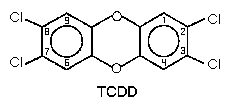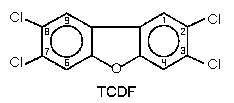


The term "dioxins", commonly covering polychlorinated dibenzo-dioxins (PCDDs) and polychlorinated dibenzo-furans (PCDFs), refers to a group of chlorinated organic chemicals with similar chemical structures.
Chlorine atoms can be attached to 8 different places on the molecule, numbered from 1 to 8. Dioxins can have varying harmful health effects depending on the number and position of the chlorine atoms. 2,3,7,8-TCDD or simply TCDD, a molecule with 4 chlorine atoms, is one of the two most toxic dioxins. Only dioxins having more chlorine atoms added to the 2,3,7,8-TCDD structure are also toxic, but to a lesser extent. Other dioxins do not show this dioxin-type toxicity.


Chlorinated chemicals with comparable structural and biochemical properties, such as certain polychlorinated biphenyls (PCB), are called "dioxin-like compounds" and can act similarly in terms of dioxin-type toxicity.
Dioxins are almost insoluble in water but have a very high affinity for lipids (fat). They also tend to associate with organic matter such as ash, soil and plant leaves. More...
Dioxins mainly derive from human activities, but can to a lower extent also be generated naturally by forest fires or volcanic activity.
Dioxins have no use as such and are formed unintentionally by industrial processes and incomplete combustion, for instance: municipal and domestic waste incineration, burning fuels (wood, coal or oil), chlorine bleaching of pulp and paper and chlorinated pesticides manufacturing.
Burning of many materials containing chlorine, such as plastics, wood treated with pentachlorophenol (PCP), pesticide-treated wastes, other polychlorinated chemicals (PCBs), and even bleached paper can produce dioxins. Cigarette smoke, home-heating systems, and exhaust from cars also contain small amounts of dioxins.
PCBs have been widely used as a dielectric and cooling fluid for electrical equipment such as transformers. More...
After emission in the atmosphere, dioxins are deposited on land or water, close to or far from the emission sources depending on the size of the particles they associate with.
Dioxins in water bind strongly to small particles, organic matter or plankton. Dioxins deposited on land bind strongly to the soil and therefore most often do not contaminate groundwater.
Most of the dioxins found in plants come from air and dust or from dioxin-containing pesticides or herbicides. Plants and animals are eaten by larger animals, which accumulate dioxins in their body and milk (bioaccumulation). Because dioxins bind to fat and are very stable, their concentrations increase with each step in the food chain (biomagnification). More...

This summary is free and ad-free, as is all of our content. You can help us remain free and independant as well as to develop new ways to communicate science by becoming a Patron!